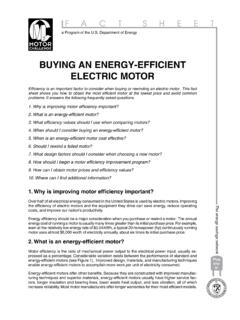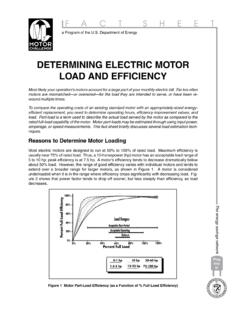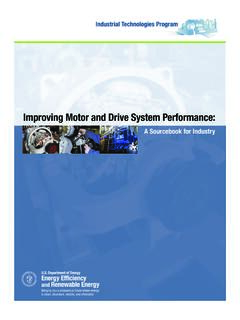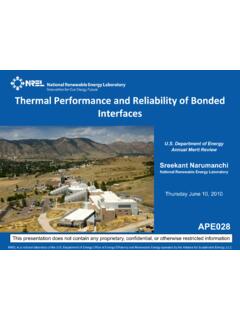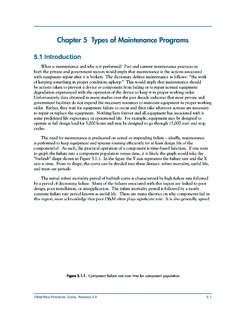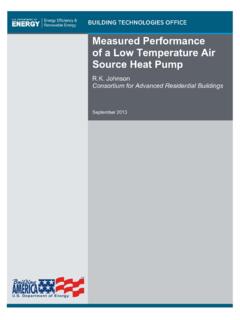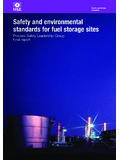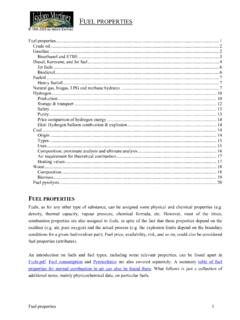Transcription of Fuel Cell and Battery Electric Vehicles Compared
1 LevelPHEVs fuel Cell and Battery Electric Vehicles Compared By C. E. (Sandy) Thomas, , President H2 Gen Innovations, Inc. Alexandria, Virginia Introduction Detailed computer simulations demonstrate that all Electric Vehicles will be required to meet our energy security and climate change reduction goals1. As shown in Figure 1, hybrid Electric Vehicles (HEV s) and plug in hybrid Electric Vehicles (PHEV s) both reduce greenhouse gas (GHG) emissions, but neither of these Vehicles that still use internal combustion engines will be adequate to cut GHGs to 80% below 1990 levels, the goal set by the climate change community, even if biofuels such as cellulosic ethanol are used in place of gasoline to power the internal combustion engines.
2 Greenhouse Gas Pollution (Light duty Vehicles only) (Billion/ tonnes CO2-equivalent/year) 100% Gasoline ICVs Base Case: Gasoline Hybrid Scenario Gasoline Plug-In Hybrid Scenario 1990 LDV GHG Ethanol Plug-In Hybrid Scenario GHG Goal: 60% below BEV 1990 Pollution Scenario H2 ICE HEV GHG Goal: 80% below 1990 Scenario Pollution - fuel Cell 2000 2010 2020 2030 2040 2050 2060 2070 2080 2090 2100 Vehicle Scenario Figure 1. Projected greenhouse gases for different alternative vehicle scenarios over the 21st century for the US light duty vehicle fleet, assuming that both the electrical grid and hydrogen production reduce their carbon footprints over time (BEV= Battery Electric vehicle; H2 ICE HEV = hydrogen internal combustion engine hybrid Electric vehicle) Thomas, Comparison of Transportation Options in a Carbon-Constrained World: Hydrogen, Plug-in Hybrids and Biofuels, the National Hydrogen Association Annual Meeting, Sacramento, California, March 31, 2008.
3 1 PHEVs C. E. Thomas fuel Cell vs. Battery Electric Vehicles Similarly, Figure 2 shows that HEV s and PHEV s powered by biofuels could not reduce oil consumption in the US to levels that would allow us to produce most of our petroleum from American sources if needed in a crisis. To achieve oil quasi independence and to cut GHGs to 80% below 1990 levels, we will have to eliminate the internal combustion engine from most light duty Vehicles . We will have to transition to all Electric Vehicles over the next few decades to meet our societal goals.
4 2000 2020 2040 2060 2080 2100 Oil Consumption (Billion barrels/year) FCEV, H2 ICE HEV & BEV Scenarios Gasoline PHEV Scenario Ethanol PHEV Scenario Base Case: Gasoline HEV Scenario 100% Gasoline ICVs Non-OPEC-only Oil American-only Oil Figure 2. Oil consumption from US light duty Vehicles over the 21st century for different alternative vehicle scenarios We have but two choices to power all Electric Vehicles : fuel cells or batteries. Both produce electricity to drive Electric motors, eliminating the pollution and in efficiencies of the venerable internal combustion engine. fuel cells derive their power from hydrogen stored on the vehicle, and batteries obtain their energy from the electrical grid. Both hydrogen and electricity can be made from low or zero carbon sources including renewable energy and nuclear energy .
5 fuel Cell and Battery Comparisons In the following sections, we compare hydrogvehicles (FCEV s) with Battery powered Electric weight, volume, greenhouse gases and cost. en powered Vehicles (BEfuel V s) cell in telectric erms of U:\My Documents\Papers\H2 Gen Position Papers\FCEV vs Battery Page 2 of 12 3/27/2009 C. E. Thomas fuel Cell vs. Battery Electric Vehicles Vehicle Weight Figure 3 compares the specific energy ( energy per unit weight) of current deep discharge lead acid (Pb A) batteries, nickel metal hydride (NiMH), Lithium Ion and the US ABC (Advanced Battery Consortium) goal with the specific energy of a PEM fuel cell plus compressed hydrogen storage tanks.
6 Two hydrogen pressures are shown: 5,000 psi and 10,000 psi with fiber wrapped composite tanks. The 10,000 psi tanks weigh more than the 5,000 psi tanks due to the requirement for extra fiber wrap to provide the needed strength2. 0 100 200 300 400 500 600 5,000 psi H2 + FC 10,000 psi H2 + FC Pb-A NiMH Lithium-Ion USABC Specific energy (Wh/kg) H2 Gen: ; Tab ' Battery '; S58 - 3 / 25 / 2009 Figure 3. The specific energy of hydrogen and fuel cell systems Compared to the specific energy of various Battery systems Compressed hydrogen and fuel cells can provide electricity to a vehicle traction motor with weights that are between eight to 14 times less than current 2 The compressed hydrogen tanks and fuel cell data are based on the following parameters.
7 fuel cell power of 60 kW, FC specific power of kW/kg, FC power density of kW/liter, 50% FC system efficiency averaged over EPA times accelerated combined driving cycle, kg of onboard hydrogen storage, carbon fiber performance factor of x106 inches, tank performance factor of x 106 inches, 70% fiber content per weight, 100 pounds/square foot fiber density, and safety factor on the hydrogen tank. U:\My Documents\Papers\H2 Gen Position Papers\FCEV vs Battery Page 3 of 12 3/27/2009 C.
8 E. Thomas fuel Cell vs. Battery Electric Vehicles batteries, and four times less than the US ABC goal. As a result, EVs must be much heavier than FCVs for a given range, as shown in Figure 4. This chart is based on a 5 passenger Ford AIV (aluminum intensive vehicle) Sable with a FCEV test weight of 1280 kg, drag coefficient of , frontal area of m2, and rolling resistance of -500 1,000 1,500 2,000 2,500 3,000 3,500 4,000 0 50 100 150 200 250 300 350 400 Range (miles) Vehicle Test Weight (kg) PbA Battery EV Li-Ion Battery EV NiMH Battery EV fuel Cell Electric Vehicle ; 'Compound' AF142 3/25 /2009 Figure 4. Calculated weight of fuel cell Electric Vehicles and Battery Electric Vehicles as a function of the vehicle range As shown here, the extra weight to increase the range of the fuel cell EV is negligible, while the Battery EV weight escalates dramatically for ranges greater than 100 to 150 miles due to weight compounding.
9 Each extra kg of Battery weight to increase range requires extra structural weight, heavier brakes, a larger traction motor, and in turn more batteries to carry around this extra mass, etc. Storage Volume Some analysts are concerned about the volume required for compressed gas hydrogen tanks. They do indeed take up more space than a gasoline tank, but compressed hydrogen tanks take up much less space (including the fuel cell system) than batteries for a given range. The basic energy density of the hydrogen fuel cell system in watt hours per liter is Compared with that of batteries in Figure 5. The hydrogen system has an inherent advantage in basic energy density. But this advantage is amplified on a vehicle as a result of weight compounding. Thus the Battery EV requires more stored energy per mile than the FCEV as a result of the heavier batteries and resulting heavier components.
10 The net effect U:\My Documents\Papers\H2 Gen Position Papers\FCEV vs Battery Page 4 of 12 3/27/2009 C. E. Thomas fuel Cell vs. Battery Electric Vehicles on the volume required for the energy supply on the car is shown in Figure 6, again as a function of range. The space to store lead acid batteries would preclude a full five passenger vehicle with a range of more than 150 miles, while the NiMH would be limited in practice to less than 200 to 250 miles 0 100 200 300 400 5,000 psi H2 + FC 10,000 psi H2 + FC Pb-A NiMH Lithium-Ion USABC energy Density (Wh/liter) H2 Gen: ; Tab ' Battery '; S34 - 3 / 25 / 2009 Figure 5.
